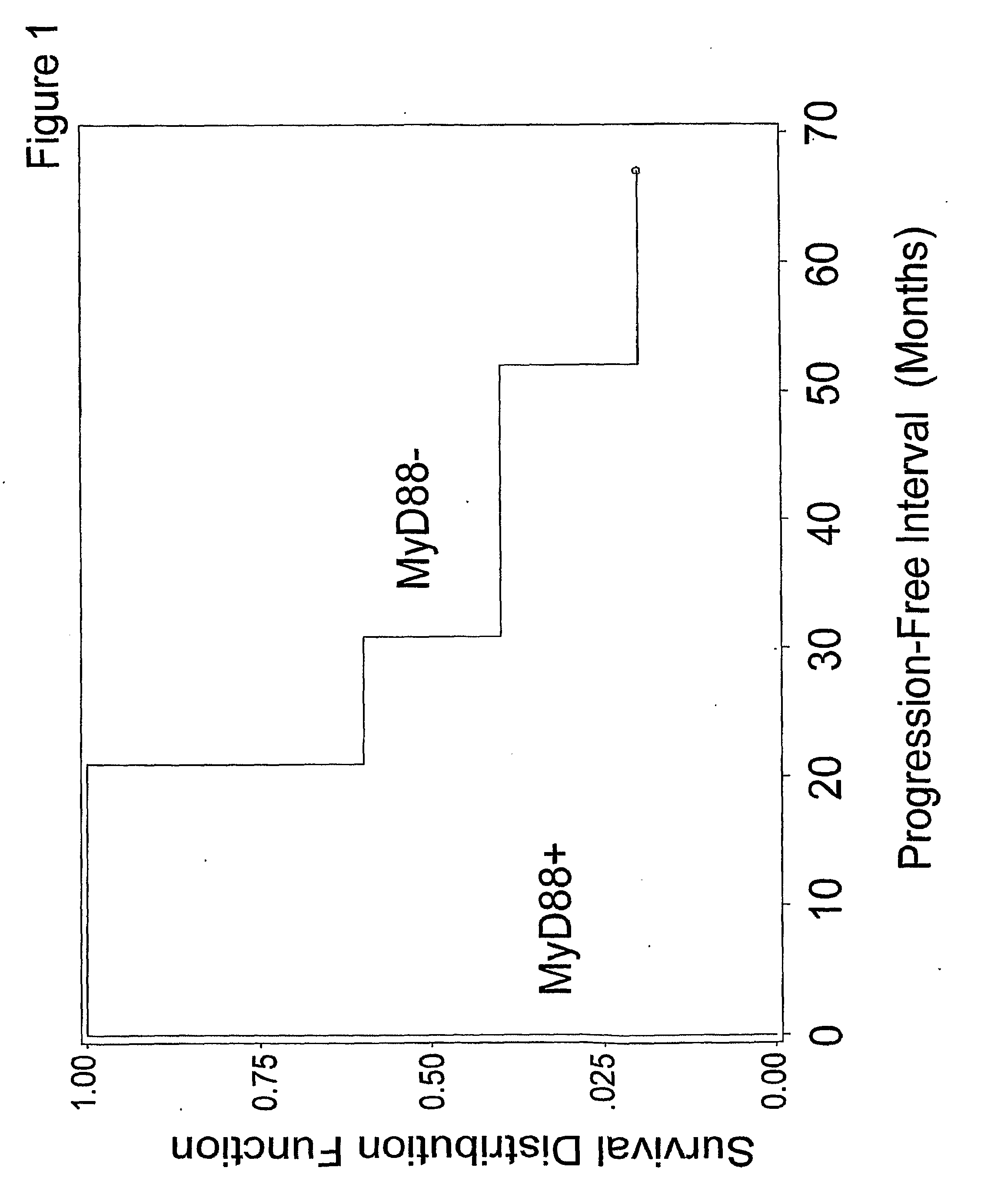Drug Resistance and Methods of Reversing
a drug resistance and drug technology, applied in the field of drug resistance and drug resistance and methods of reversing, can solve the problems of 1 in 67 chance of developing ovarian cancer, poor prognosis, and death of gynecologic cancer
- Summary
- Abstract
- Description
- Claims
- Application Information
AI Technical Summary
Benefits of technology
Problems solved by technology
Method used
Image
Examples
example 1
EOC Expression of TLR-4 and the Signaling Adapter Protein MyD88
[0055]First, Applicants determined whether TLR-4 is expressed in EOC cells. TLR-4 expression was evaluated in paraffin sections of ovarian cancer tissues. Positive immunoreactivity for TLR-4 was observed in the tumor cells, but not in the neighboring non-dysplastic cells. The staining was localized in the cytoplasm as well as on the cell surface. Next, TLR-4 expression was evaluated in EOC cell lines isolated from malignant ovarian ascites and from ovarian cancer tissues. Positive immunoreactivity for TLR-4 was observed in all of the evaluated EOC cell lines. The staining pattern was similar to that observed on the paraffin sections. No staining was observed when mouse IgG1 was used as negative control.
[0056]To confirm the specificity of these findings, the expression of TLR-4 by EOC cells and tumors was further evaluated by RT-PCR and Western blot analysis. EOC cells and tumors expressed TLR-4, both at the mRNA and prot...
example 2
MyD88 Expression is Required for LPS-Induced Tumor Growth
[0059]Once the expression of TLR-4 in EOC samples was established, Applicants evaluated the biological function of this receptor and also evaluated the significance of MyD88 status. EOC cell lines expressing MyD88 (MyD88+) and those shown to lack MyD88 (MyD88−) were treated with increasing concentrations of LPS (one of the main ligands for TLR-4) for 24 h and 48 h and cell viability was determined using the CellTiter 96® AQueous One Solution Cell Proliferation Assay. A significant increase in cell proliferation was observed at 24 h (p+, but not in MyD88− EOC cells. Thus, LPS induced a time- and dose-dependent increase in cell proliferation in cells expressing MyD88, but not in MyD88− EOC cells. LPS had no effect on viability of OSE cell, which are also negative for MyD88 expression. These results support the dependence of the proliferative effect of LPS in EOC cells on the presence of MyD88.
example 3
TLR-4 Ligation by LPS Induced Cytokine Production in MyD88 Expressing Cell Lines
[0060]One of the main characteristics of TLR-4 ligation by LPS in cells of the immune system is the induction of cytokine production, mainly of the pro-inflammatory type. Thus, Applicants' next objective was to evaluate whether TLR-4 ligation by LPS would have a similar effect in EOC cells. Thus, MyD88+ EOC cells were incubated in the presence or absence of 10 μg / ml LPS for 48 h and cytokine secretion was evaluated in the cell-free culture supernatants using a human cytokine array. MyD88+ EOC cells constitutively secreted a wide range of proinflammatory cytokines and chemokines and this secretion was further enhanced by TLR-4 ligation with LPS.
[0061]The results from the cytokine array led to the identification of specific cytokines / chemokines that were significantly affected by LPS treatment. To validate these results, Applicants performed ELISA and compared the differential response between MyD88+ and M...
PUM
| Property | Measurement | Unit |
|---|---|---|
| Electrical resistance | aaaaa | aaaaa |
Abstract
Description
Claims
Application Information
 Login to View More
Login to View More - R&D
- Intellectual Property
- Life Sciences
- Materials
- Tech Scout
- Unparalleled Data Quality
- Higher Quality Content
- 60% Fewer Hallucinations
Browse by: Latest US Patents, China's latest patents, Technical Efficacy Thesaurus, Application Domain, Technology Topic, Popular Technical Reports.
© 2025 PatSnap. All rights reserved.Legal|Privacy policy|Modern Slavery Act Transparency Statement|Sitemap|About US| Contact US: help@patsnap.com



